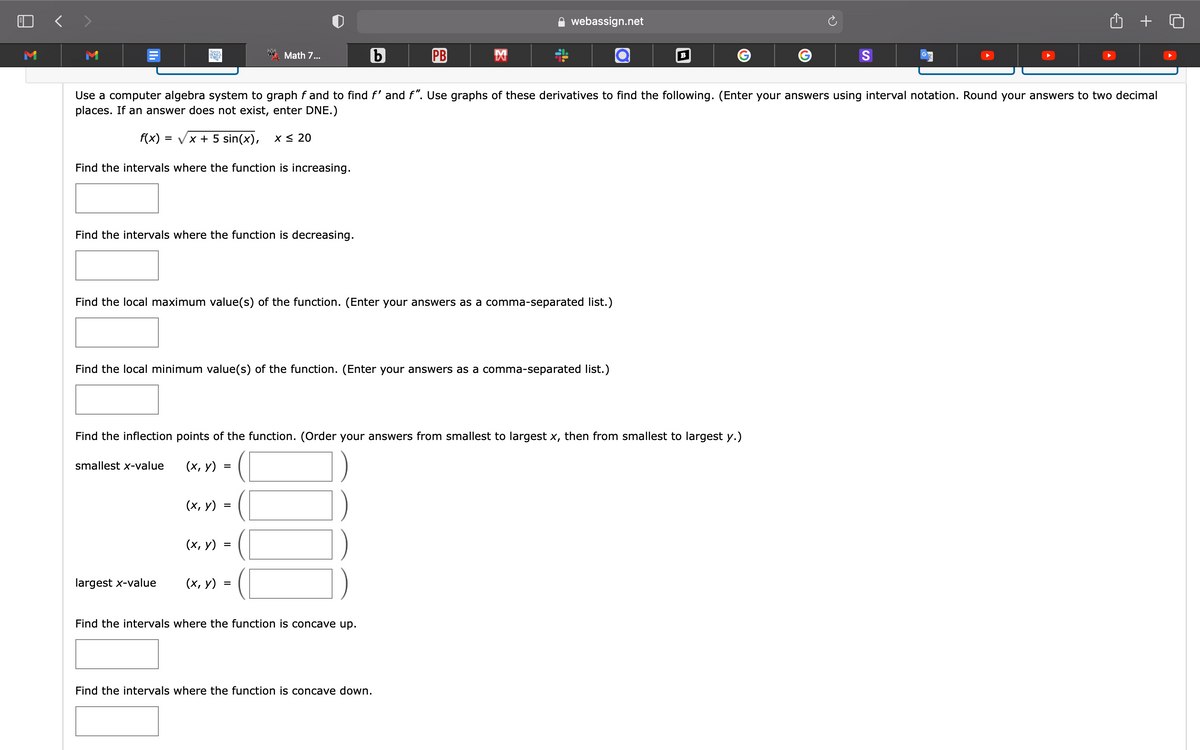Use a computer algebra system to graph f and to find f' and f". Use graphs of these derivatives to find the following. (Enter your answers using interval notation. Round your answers to two decimal places. If an answer does not exist, enter DNE.) f(x)=√x + 5 sin(x), x≤ 20 Find the intervals where the function is increasing. Find the intervals where the function is decreasing. Find the local maximum value(s) of the function. (Enter your answers as a comma-separated list.)
Use a computer algebra system to graph f and to find f' and f". Use graphs of these derivatives to find the following. (Enter your answers using interval notation. Round your answers to two decimal places. If an answer does not exist, enter DNE.) f(x)=√x + 5 sin(x), x≤ 20 Find the intervals where the function is increasing. Find the intervals where the function is decreasing. Find the local maximum value(s) of the function. (Enter your answers as a comma-separated list.)
Functions and Change: A Modeling Approach to College Algebra (MindTap Course List)
6th Edition
ISBN:9781337111348
Author:Bruce Crauder, Benny Evans, Alan Noell
Publisher:Bruce Crauder, Benny Evans, Alan Noell
Chapter2: Graphical And Tabular Analysis
Section2.1: Tables And Trends
Problem 1TU: If a coffee filter is dropped, its velocity after t seconds is given by v(t)=4(10.0003t) feet per...
Related questions
Question

Transcribed Image Text:webassign.net
+ 0
Math 7...
b
PB
M
#
S
Use a computer algebra system to graph f and to find f' and f". Use graphs of these derivatives to find the following. (Enter your answers using interval notation. Round your answers to two decimal
places. If an answer does not exist, enter DNE.)
f(x) = = √x + 5 sin(x), X ≤ 20
Find the intervals where the function is increasing.
Find the intervals where the function is decreasing.
Find the local maximum value(s) of the function. (Enter your answers as a comma-separated list.)
Find the local minimum value(s) of the function. (Enter your answers as a comma-separated list.)
Find the inflection points of the function. (Order your answers from smallest to largest x, then from smallest to largest y.)
smallest x-value
=
(x, y)
(x, y)
(x, y)
largest x-value
(x, y)
=
Find the intervals where the function is concave up.
Find the intervals where the function is concave down.
=
Expert Solution
This question has been solved!
Explore an expertly crafted, step-by-step solution for a thorough understanding of key concepts.
This is a popular solution!
Trending now
This is a popular solution!
Step by step
Solved in 6 steps with 1 images

Recommended textbooks for you

Functions and Change: A Modeling Approach to Coll…
Algebra
ISBN:
9781337111348
Author:
Bruce Crauder, Benny Evans, Alan Noell
Publisher:
Cengage Learning

Functions and Change: A Modeling Approach to Coll…
Algebra
ISBN:
9781337111348
Author:
Bruce Crauder, Benny Evans, Alan Noell
Publisher:
Cengage Learning